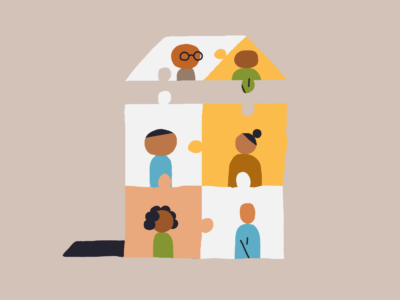Think of our current housing system as a game of musical chairs. There are more people than affordable homes. Just as not everyone can get a chair when the music stops, not everyone can get a home. Those who struggle the most, because of a disability, low wages, or other challenges, are most likely to lose. Even those who work hard to improve their situation can lose their home due to things they can’t control.
But imagine if we changed the rules, adding more chairs instead of taking them away, and helping people to find an open chair by removing obstacles in their way. We allow people to stay in the game, even when they are struggling, and create a situation where everyone is able to win.
Systems are designed by people — and they can be redesigned.
Across the country, more people than ever before have been displaced from their homes. As of January 2023, more than 650,000 people were estimated to be experiencing homelessness during the nation’s annual point-in-time count — a 12% increase over the previous year’s estimate and the highest number reported since 2007.
While the news about homelessness is grim, we see evidence and hope that solutions are within our grasp.
Through the Built for Zero network, we support 132 communities in changing how they approach homelessness to ensure everyone has a home. We work with communities to build resilient community housing systems where everyone works together, using data-driven methodologies, to make homelessness rare and brief. More than 40% have achieved a measurable reduction in homelessness and are showing that every type of community can build a housing system that steadily makes homelessness rare and brief.
Take Denver, for instance, which reduced homelessness among veterans by 21% in 2023. In the past three years, Detroit has reduced veteran homelessness by nearly 50%. And in Hennepin County, Minnesota — home to Minneapolis — chronic homelessness is down by nearly a third.
Meanwhile, smaller and mid-sized communities — like Rockford, Illinois, and the Gulf Coast region of Mississippi — have reached a point where homelessness is rare, brief, and nonrecurring for more than one population. These communities have built the muscle to rehouse those who fall into homelessness within 30 days.
Communities are making progress by working differently. They define success by whether homelessness across their entire geography is being reduced, not whether individual programs are performing well. Local nonprofit and government agency staff work as a team toward the single goal of reducing homelessness. They know — by name and in real time — all those experiencing homelessness. This clear, comprehensive view allows them to see quickly what policies and investments are leading to success and to focus on what works.
At the end of 2023, 71 communities had real-time, quality data on every person in their target population experiencing homelessness, their history, and their needs. Across the country, community teams are more coordinated, collaborative, and confident in their ability to make homelessness rare and brief.
Our evaluation partners at ORS Impact have been taking a deep look at the work being done to solve homelessness in Built for Zero communities. We’ve summarized the findings from the ORS Year Two report and shared the deeper learnings in our Annual Impact Report.
I’d like to highlight five stories that capture key learnings from 2023 in communities large and small.
System-level change in homelessness requires deep collaboration
Denver offers a great example of a unified local effort. The Metro Denver Homeless Initiative (MDHI) is responsible for solving homelessness across seven counties, 40 municipalities, and a population of 3.2 million. To tailor solutions to diverse local conditions, they’ve divided their region into nine subregions, each with its own focus.
As the “backbone” organization coordinating the efforts of each local team within the region. MDHI convenes the key nonprofit and government agencies that must work together to reduce homelessness, builds buy-in for working as a team, and assists each local group with implementing Built for Zero’s data-driven practices for achieving results. Each subregion has its own executive team, homeless coordination team, and case conferencing teams, but reports up to MDHI.
This multi-layered approach is working: Metro Denver has reduced veteran homelessness by 30%.
High-quality, shared data on homelessness makes progress possible
A central feature of Built for Zero’s method is the use of real-time, by-name data to obtain a true picture of the dynamics of homelessness in a community and to guide action.
“You can’t solve a problem that you can’t see. And you need that data piece to also see that our investments and our program changes are getting us where we want to go,” explained Catrina Peters, Homeless Services Coordinator with Washoe County Housing and Homeless Services. “We don’t want to waste precious resources. We want to see dollars and effort going to programs that are going to solve homelessness.”
This year, Washoe County, Nevada — home to Reno — reached quality data for all single adults experiencing homelessness in the county. At its peak, Washoe County had a by-name list of almost 2,500 people experiencing homelessness in their community. Within a year, they reduced that number by 28%.
Solving homelessness requires eliminating racial inequality in outcomes
Collecting quality data can help communities make sure their housing systems aren’t perpetuating racial disparities. According to ORS Impact’s 2023 research, about 75% of Built for Zero communities surveyed have already begun to take specific action toward countering racial disparities in housing outcomes.
“All of our data is broken out by race and ethnicity, but also equitable housing outcomes,” shared the leader of one Built for Zero community. “So, everything — any housing outcomes, programs in the shelter, our own Homeless to Housing — everything is broken out to make sure that nothing is skewing in (a biased) direction.”
Communities can change the story around homelessness
The myth that homelessness is intractable has consequences. The myth diminishes hope and energy, and the support needed to implement proven solutions. To tell the story of progress communities are now using their data to show the public a new picture of homelessness and what is possible.
San Diego’s public dashboard is released monthly. It’s designed to show the current state of homelessness: displaying the number of people housed that month as well as the number still experiencing homelessness. Altogether it tells a story of remarkable achievement as well as the specific challenge the community faces as more and more households are overwhelmed by high housing costs. Hundreds are housed from homelessness each month in San Diego, yet as the dashboard shows, hundreds of newly homeless households come into their system at the same time.
“We must recognize the importance of putting together strong narratives through the data we have,” shared Tamera Kohler, the CEO of the Regional Task Force on Homelessness.
On average, 10 people are housed monthly for every 13 people who experience homelessness for the first time.
“People are now talking about how we can reduce the numbers coming in instead of the fault of the system not meeting the needs,” Kohler said. “That’s a very different conversation.”
Many types of housing solutions are needed
More affordable homes and safe, stable living options are urgently needed in almost every community. The crisis is prompting needed innovations in finance, construction and living arrangements as well as a growing movement to clear regulatory barriers to new housing. To accelerate reductions in homelessness in the near term, Community Solutions has focused on increasing access to existing homes. Over the past two years, social impact investors have enabled us to acquire existing multi family rental properties in targeted large cities toward making veteran and chronic homelessness rare and brief. To date:
- 1,335 affordable homes have been acquired and connected to local homeless response systems
- Six markets have been impacted by this new approach to creating an integrated housing system that prevents and ends homelessness
To help individuals make the transition from homelessness, we have instituted our “Property Management Plus” system that trains property managers to collaborate with service providers to rebuild their lives and remain stably housed.
“We don’t feel that we’re just the regular property management,” explained Angie Sandy from TI Asset Management, operators of our Centra Villa Apartments in Atlanta. “We try to do whatever we can to not just make a home for the tenants, but also to make a community for the tenants.”
Read more from our 2023 Impact and Learning Report

The future we can build together

Our path toward a tipping point

Helping communities solve homelessness

Supporting equitable homeless response systems

Solving key data and collaboration challenges





